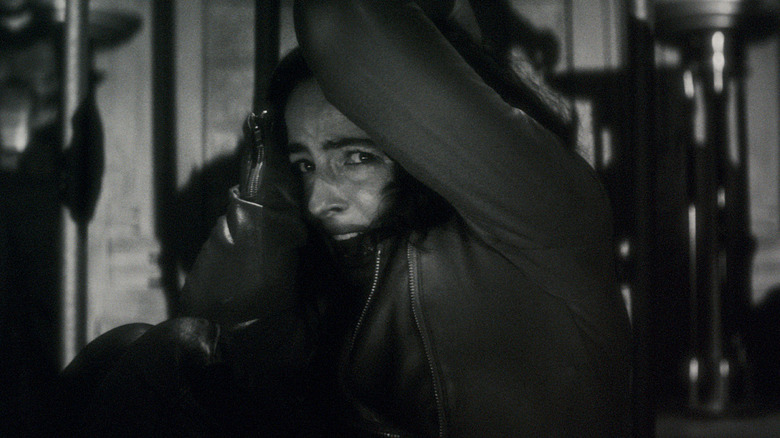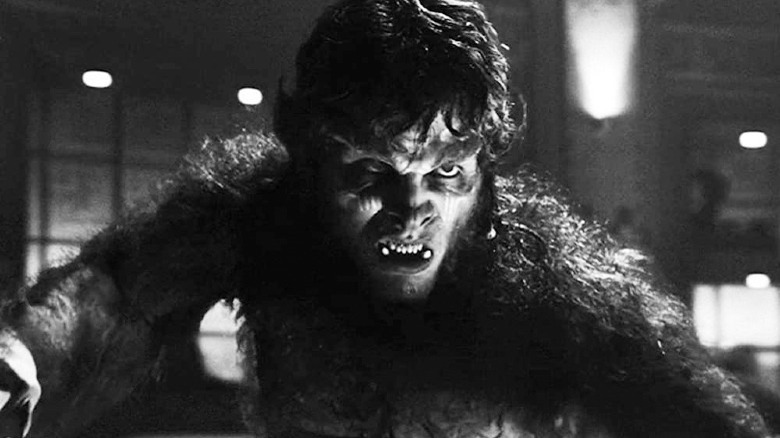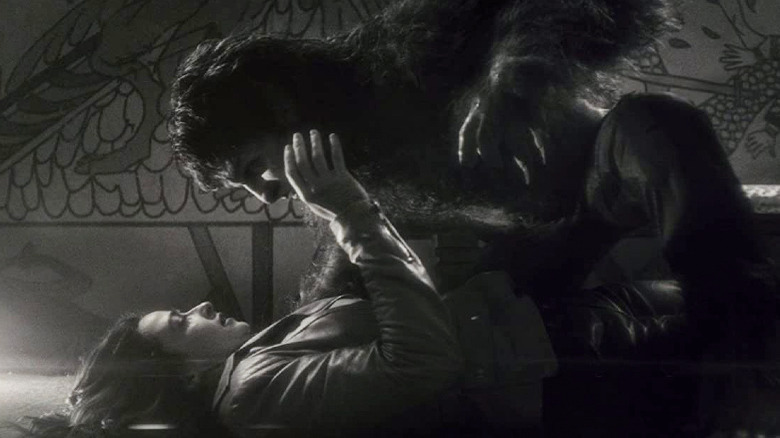How Director Michael Giacchino Pulled Off Werewolf By Night's Big Transformation Scene [Exclusive]
Werewolf transformations are old hat for filmmakers, but that's not to say they're easy. When George Waggner directed 1941's "The Wolf Man," he was limited to depicting Larry Talbot's (Lon Chaney Jr.) monstrous makeover by dissolving between different shots of Chaney taken at various stages in the application of his makeup. By the time John Landis made "An American Werewolf in London" 40 years later, advances in makeup and movie tech allowed the director to portray the werewolf transformation process in a far more convincing and disturbing fashion.
Wisely, "Werewolf by Night" director Michael Giacchino avoided repeating the mistakes of Joe Johnston's 2010 film "The Wolfman" (which merges CGI with practical effects to clunky results) when it was his turn to show a human changing into their lycanthrope state. Giacchino's Marvel special follows a pack of monster hunters as they gather one night to compete in a special monster hunt that will determine their new leader. What they don't know (not at first, anyway) is that one of their own — a fellow by the name of Jack Russell (Gael García Bernal) — is actually a creature of the night himself. Eventually, though, Jack is found out and is forced to change into his werewolf state.
"Well, there are so many great werewolf transformations that have been done in the world and to try and outdo them felt foolish to me," explained Giacchino, speaking in an exclusive interview with /Film's Jack Giroux. So he went in a different direction.
Less is more
Wanting to tip his hat to classic Universal black-and-white monster horror movies like "The Wolf Man," Giacchino chose to utilize practical effects as much as possible on "Werewolf by Night." That extended to Jack's transformation, most of which takes unfolds off-screen in a 25-second push-in on Elsa Bloodstone (Laura Donnelly), a fellow monster hunter who is trapped in a large cage with Jack as he changes. All we the viewers see is Elsa's terrified expression as flashing lights project the outline of Jack's morphing body onto the wall behind her. The sound of his anguished screams warping into low, guttural growling fills in the blanks.
Similar to how the special's black-and-white visuals allow it to include its fair share of bloody violence while retaining a TV-14, shooting Jack's transformation this way leaves much of the process to viewers' imagination (where it's bound to be more unsettling anyway). However, Giacchino says his approach was also influenced by his realization that this moment is more about Elsa and what she's feeling rather than Jack:
"I felt, okay, let's not even show Jack on camera, let's have his shadow there, but really keep pushing in on her face. To me, that was what it's all about, just Elsa in that moment. I felt so bad for her being trapped there."
He went on to confirm that he, too, believes less is more when it comes to creating horror:
"To keep [Jack] off camera and just use the shadows, that's scarier. Hearing those sounds is scarier. And then seeing the reaction on her face as this is happening, to me, that's scarier. So, that was the reasoning behind all of it. It was one of the first shots I had planned out from the very beginning."
Keeping it in-camera
Despite being planned well in advance, Giacchino admitted actually executing Jack's transformation and making it look good was easier said than done. Complicating matters, he was committed to staying faithful to the aesthetic of old-school Universal horror, as much as any polished studio project made these days can look like it legitimately dates back to an era of film reel changes and scratched-up celluloid. That meant taking a page out of Francis Ford Coppola's book for "Bram Stoker's Dracula" (to cite what feels like an appropriate example) and doing the whole thing in-camera:
"I knew that's how I wanted to do it. It took months to make that work, because it was all done in-camera, too. That whole shot, that's not a VFX shot. It was crazy to try and sort that out. The only thing that was not on set when we shot it were the bars. We had to add those in later because of the way where the projector was projecting the shadow of the transformation. We had to make sure all of that lined up and looked like it was coming from Elsa's POV."
"Everything else is real," Giacchino added. "Elsa was there, the walls, everything else. The shadow was being projected as we shot it, and it was crazy how it all worked. Again, it took a lot of preparation." All that hard work pays off handsomely in "Werewolf by Night," a tightly-paced, nifty spooky season offering that's far more treat than trick.
"Werewolf by Night" is now streaming on Disney+.


